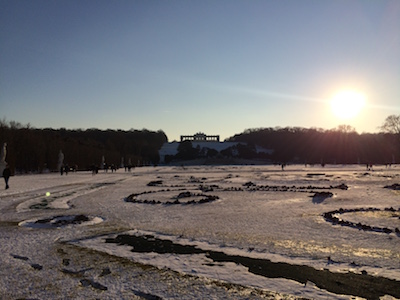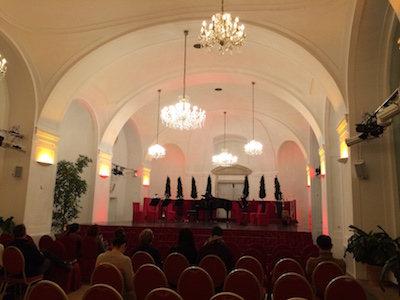Vienna is practically packed with two things: sausages and palaces. The famed Vienna sausages are an expensive delicacy here, so enjoy their mass-produced fatty-jellied goodness for pennies back home before coming here. It’s the palaces that this blog is about, particularly the Schönbrunn Palace.
We didn’t actually enter a palace until the afternoon of our last day in Vienna, this despite tripping over and bumping into palaces at every turn in Vienna. If I had a Euro for every time I said, “Oops, damn, there’s another palace”… We did “walk-by’s” of Vienna’s other popular palaces, the Hofburg and the Belvedere, figuring we only needed to see one. I mean, how many opulent apartments and staterooms does one really need to see in the span of a week?
The Schönbrunn (SHOWN-broon) also offered the benefit of a concert. We were wooed and cajoled into buying concert tickets by one of those slick sales guys on the street in front of the opera house. After the hypnotism wore off, we found in our hands tickets for a Friday night concert at the palace’s Orangery hall. He also recommended a great restaurant nearby, so our palace tour afternoon followed by dinner and a concert were set.
The Schönbrunn was actually the summer residence of the Habsburg emperors from 1740. A mere “mansion” occupied the property for a couple of centuries before, set amid a few hundred acres of carefully manicured gardens and ponds surrounded by woodland. Emperor Maximilian had the entire grounds fenced and populated with game and deer which he could shoot at from the comfort of his smoking study window. It was the Empress Maria Theresa (the very progressive Habsburgs had no problem with women occupying the seat of power) who built the palace we see today in the mid 1700’s.

It is a huge, single building of over 1,400 rooms in eye-popping baroque style. When you tour there are two options: one to see the basics, the other a step up to see the good stuff. If you visit, don’t bother with the cheaper basic tour: you’ll be corralled out of the palace in cruel sight of the sumptuous staterooms you didn’t pay to see. Photos aren’t allowed within the palace, so sorry, our blog is devoid of visual embellishment. You’ll just have to trust us that it’s worth seeing.
What we were really struck with was the history of those rooms. We stood in the small parlor where a 7-year old Mozart charmed the Empress before jumping into her lap and giving her an impertinent kiss on the cheek. We admired a portrait of the emperor Franz Joseph in the room he died in. We (re-)learned how Napoleon had married into the Habsburg family…in the room he slept in when he came to visit. And in the resplendent grand ballroom, where Kennedy stared down Kruschev (and Jackie charmed him), we waltzed.
The grand tour takes just a couple of hours (it’s advertised to take 90 minutes, but if you’re like us, you like to get your visit’s money’s worth), so we had arrived late and found ourselves leaving the building just as they were closing. It was a beautiful twilight evening, snow covering the ground, so we wandered a bit, just until the cold got annoying, then headed to our restaurant where we had stopped and made reservations before. It was the Restaurant Schönbrunner Stöckl, in the far eastern end of the palace building complex. For genuine Austrian cuisine at a great price and in a great atmosphere, it can’t be beat.
From there we went around the corner to the Orangery for our concert. In years past this room was where the Habsburgs grew citrus trees, not only because they were tasty exotics but also for the vitamin C. It must have been a lovely room filled with orange and lemon trees, and one can only imagine the delightful smell. Concerts have long been held in this room, it was such a splendid space. In fact it was in this same room where Mozart battled it out with his arch-nemesis Salieri for the attention of the Viennese press, the conflict that was the plot basis for the movie “Amadeus”. The night we visited, the citrus trees were long gone, replaced instead with us and a few British and Japanese tourists, but the room was still filled with the sounds of Mozart mingled with a bit of Strauss.







